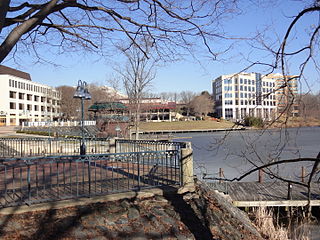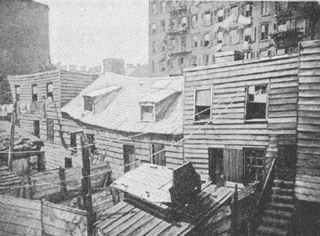Related Research Articles

Columbia is a census-designated place in Howard County, Maryland, United States. It is a planned community consisting of 10 self-contained villages. The census-designated place had a population of 104,681 at the 2020 census, making it the second most populous community in Maryland after Baltimore. Columbia, located between Baltimore and Washington, D.C., is officially part of the Baltimore metropolitan area.
James Wilson Rouse was an American businessman and founder of The Rouse Company. Rouse was a pioneering American real estate developer, urban planner, civic activist, and later, free enterprise-based philanthropist. He received the Presidential Medal of Freedom, the highest civilian award, for his lifetime achievements.

The United States Department of Housing and Urban Development (HUD) is one of the executive departments of the U.S. federal government. It administers federal housing and urban development laws. It is headed by the Secretary of Housing and Urban Development, who reports directly to the President of the United States and is a member of the president's Cabinet.
The Community Development Block Grant (CDBG), one of the longest-running programs of the U.S. Department of Housing and Urban Development, funds local community development activities with the stated goal of providing affordable housing, anti-poverty programs, and infrastructure development. CDBG, like other block grant programs, differ from categorical grants, made for specific purposes, in that they are subject to less federal oversight and are largely used at the discretion of the state and local governments and their subgrantees.

Urban renewal is a program of land redevelopment often used to address urban decay in cities. Urban renewal involves the clearing out of blighted areas in inner cities to clear out slums and create opportunities for higher class housing, businesses, and other developments. In the United States the term technically refers only to a federal program in the middle-to-late 20th Century, but colloquially is sometimes used to refer to any large-scale change in urban development.

The Rouse Company, founded by Hunter Moss and James W. Rouse in 1939, was a publicly held shopping mall and community developer from 1956 until 2004, when General Growth Properties (GGP) purchased the company.

Marshall Heights is a residential neighborhood in Southeast Washington, D.C. It is bounded by East Capitol Street, Central Avenue SE, Southern Avenue, Fitch Street SE, and Benning Road SE. It was an undeveloped rural area occupied by extensive African American shanty towns, but the neighborhood received nationwide attention after a visit by First Lady Eleanor Roosevelt in 1934, which led to extensive infrastructure improvements and development for the first time. In the 1950s, Marshall Heights residents defeated national legislation designed to raze and redevelop the neighborhood. Queen Elizabeth II of the United Kingdom visited the area in 1991, at a time when Marshall Heights was in the throes of a violent crack cocaine epidemic. Limited redevelopment has occurred in the neighborhood, which was the site of two notorious child murders in 1973.

Owen Brown is one of the ten villages in Columbia, Maryland, United States, established in 1972. Neighborhoods in the village include Dasher Green, Elkhorn and Hopewell. Owen Brown lies south and east of the town center.
The Urban Growth and New Community Development Act is a statute enacted by the United States Congress in 1970.

The Philadelphia Housing Authority (PHA) is a municipal authority providing Public housing services in Philadelphia, Pennsylvania.

The American Housing Act of 1949 was a landmark, sweeping expansion of the federal role in mortgage insurance and issuance and the construction of public housing. It was part of President Harry Truman's program of domestic legislation, the Fair Deal.

In the United States, subsidized housing is administered by federal, state and local agencies to provide subsidized rental assistance for low-income households. Public housing is priced much below the market rate, allowing people to live in more convenient locations rather than move away from the city in search of lower rents. In most federally-funded rental assistance programs, the tenants' monthly rent is set at 30% of their household income. Now increasingly provided in a variety of settings and formats, originally public housing in the U.S. consisted primarily of one or more concentrated blocks of low-rise and/or high-rise apartment buildings. These complexes are operated by state and local housing authorities which are authorized and funded by the United States Department of Housing and Urban Development (HUD). In 2020, there were 1 million public housing units. In 2022, about 5.2 million American households that received some form of federal rental assistance.

The Housing and Urban Development Act of 1968, Pub. L.Tooltip Public Law 90–448, 82 Stat. 476, enacted August 1, 1968, was passed during the Lyndon B. Johnson Administration. The act came on the heels of major riots across cities throughout the U.S. in 1967, the assassination of Civil Rights Leader Martin Luther King Jr. in April 1968, and the publication of the report of the Kerner Commission, which recommended major expansions in public funding and support of urban areas. President Lyndon B. Johnson referred to the legislation as one of the most significant laws ever passed in the U.S., due to its scale and ambition. The act's declared intention was constructing or rehabilitating 26 million housing units, 6 million of these for low- and moderate-income families, over the next 10 years.
The Housing Act of 1954, Pub. L.Tooltip Public Law 83–560, 68 Stat. 590, enacted August 2, 1954, passed during the Dwight D. Eisenhower Administration, comprised a series of amendments to the National Housing Act of 1934. Referred to within the legislation simply as the "National Housing Act", the program was managed by the Federal Housing Administration (FHA), an agency created by the 1934 Act. Previous amendments to the 1934 Act were made in 1937 and 1949.
American Council to Improve Our Neighborhoods (ACTION) is the former name of a non-profit organization focused on housing, revitalization, and neighborhood renewal in the United States.
Guy T. O. Hollyday (1893–1991) was an American proponent of urban housing renewal.
The Forest Houses are a housing project in Morrisania, Bronx. The project consists of fifteen buildings, 9, 10 and 14-stories tall with 1,350 apartment units. It covers a 17.72-acre expanse, and is bordered by East 163rd and East 166th Streets, and Trinity and Tinton Avenues. It is owned and managed by New York City Housing Authority (NYCHA).
Vacants to Value is a Baltimore initiative enacted in 2010 by former Mayor Stephanie Rawlings-Blake to incentivize purchases of abandoned homes in the city. The program offers financial incentives to purchase derelict properties and renovate them.

Slum clearance in the United States has been used as an urban renewal strategy to regenerate derelict or run-down districts, often to be replaced with alternative developments or new housing. Early calls were made during the 19th century, although mass slum clearance did not occur until after World War II with the introduction of the Housing Act of 1949 which offered federal subsidies towards redevelopments. The scheme ended in 1974 having driven over 2,000 projects with costs in excess of $50 billion.
Eight Mile-Wyoming area is located nearly 10 miles (16 km) from Paradise Valley on the northern boundary of Detroit and minimally resembled inner-city neighborhoods. Originally settled in the 1920s by thousands of optimistic migrant farmers, the area became a settlement opportunity for Blacks to construct and own their own homes. The area was fought over for development and housing projects for decades and represented an isolated concentration of Blacks in a vast population of whites.
References
- ↑ Baltimore (Md.). The Ordinances of the Mayor and City Council of Baltimore. p. 204.
- ↑ Nicholas Dagen Bloom. Merchant of Illusion James Rouse, Americas Salesman of the Businessmans Utopia. p. 64.
- ↑ "Morton Froelicher Collection" . Retrieved 24 December 2013.
- ↑ Nicholas Dagen Bloom. Merchant of Illusion James Rouse, Americas Salesman of the Businessmans Utopia.
- ↑ "A Law Spelling Out The "Baltimore Plan"". The Baltimore Sun. 7 February 1951.
- ↑ Joseph Rocco Mitchell, David L. Stebbenne. A New City Upon a Hill. p. 51.
- ↑ Paul Marx. Jim Rouse: Capitalist/idealist. p. 51.
- ↑ "These Slumlords Got Smart". Saturday Evening Post. 31 January 1953.
- ↑ Nicholas Dagen Bloom. Merchant of Illusion James Rouse, Americas Salesman of the Businessmans Utopia. p. 68.
- ↑ Federalist. 4 September 1953.
{{cite journal}}: Missing or empty|title=(help) - ↑ James Rouse (1954). The Impact of Housing Improvement on the Community.
- ↑ Joseph Rocco Mitchell, David L. Stebbenne. A New City Upon a Hill. p. 43.
- ↑ Action. Case study Baltimore Fight Blight Fund.